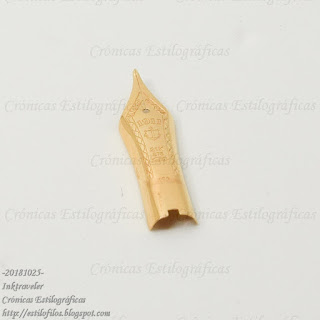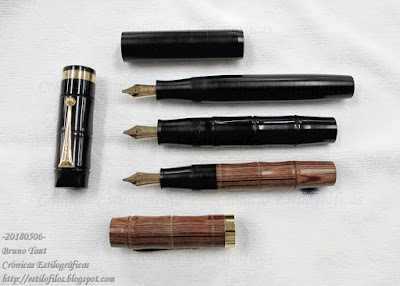Few elements in a pen are really standardized. Each maker created –still creates– many of the components and they only had to match the other parts of the pen without any regard to other manufacturers.
The closes one could get to normalization was in the area of nibs, where at some point there was a consensus about their sizes. In that environment, sizes 6 and 8 were quite big; sizes
10 and 12 were huge, rare, expensive and highly desirable.
And half the world away, Japanese pen makers had their own life to live. Sure Pilot numbered their nibs in a similar fashion --
from 0 to 8--, but the consistency in the size was far from exemplary. Sailor, on its side, used some crazy numbers—sizes
30,
80, and 200 for some of the nibs that, in actuality, were rather small.
Nowadays, Japanese makers are very consistent in the sizing of their nibs, but the naming is very arbitrary.
Pilot, on its more common line of nibs, calls them as 3, 5, 10, 15, 20, 30, 50. These numbers, however, do not mean much.
Platinum has three basic nibs—the 3776 with two and three tines, and the President. There is no indication of size.
Sailor, finally, has three basic sizes called medium, big and superbig.
And in the West, German nibs –third party nibs—tend to follow a more systematic approach. Bock nibs, albeit having their own number, follow a relevant pattern—the diameter of the feed. And the same happens with JoWo nibs: the feed diameter sets the nib size.
So, the question is how all these nibs –Japanese and German—compare. The following tables show the diameters of the feed of some manufacturers:
Pilot-Namiki
Nib
description |
Feed
diameter
(mm)
|
| 5 |
6.0 |
| 10 |
6.2 |
| 15 |
6.4 |
| 20 |
6.5 |
| 30 |
7.6 |
| 50 |
9.0 |
 Pilot and Namiki nibs. From left to right, sizes 5, 10, 15, 20, and 50. Sizes 20 and 50 are implemented currently only on Namiki pens. However, the examples here shown are still Pilot (::1::, ::2::). Missing on the table is size 3. And from the picture, sizes 3 and 30.
Pilot and Namiki nibs. From left to right, sizes 5, 10, 15, 20, and 50. Sizes 20 and 50 are implemented currently only on Namiki pens. However, the examples here shown are still Pilot (::1::, ::2::). Missing on the table is size 3. And from the picture, sizes 3 and 30.
Platinum-Nakaya
Nib
description |
Feed
diameter
(mm)
|
3776 old model
music 2-tined nib |
6.0 |
| 3776 new model |
6.5 |
 Two 3776 nibs. These are the nibs implemented on Nakaya pens, the "alter ego" of Platinum. On the left, the feed and the nib of the old version of the regular nibs. This feed is still used on the music nibs of Platinum and Nakaya. On the right, the modern nib and feed of the 3776 series of pens and of Nakaya pens save for the cases of music nibs. Missing on the table and on the picture, the President nib.
Two 3776 nibs. These are the nibs implemented on Nakaya pens, the "alter ego" of Platinum. On the left, the feed and the nib of the old version of the regular nibs. This feed is still used on the music nibs of Platinum and Nakaya. On the right, the modern nib and feed of the 3776 series of pens and of Nakaya pens save for the cases of music nibs. Missing on the table and on the picture, the President nib.
Sailor
Nib
description |
Feed
diameter
(mm)
|
| Medium |
5.8 |
| Big |
6.4 |
 Sailor nibs and feeds of sizes medium (left) and big. Missing on the picture and on the table, the "super big" size of the "King of Pen" models.
Sailor nibs and feeds of sizes medium (left) and big. Missing on the picture and on the table, the "super big" size of the "King of Pen" models.
Bock
Nib
description |
Feed
diameter
(mm)
|
| 060, 076, 180 |
5.0 |
| 220, 250 |
6.0 |
| 380 |
8.0 |
JoWo
Nib
description |
Feed
diameter
(mm)
|
| #5 |
5.0 |
| #6 |
6.0 |
| #8 |
8.0 |
 From left to right: Bock model 250 (6.0 mm in diameter), Bock model 380 (8.0 mm), and JoWo nib of size #6. All the feeds on the picture are made of ebonite.
From left to right: Bock model 250 (6.0 mm in diameter), Bock model 380 (8.0 mm), and JoWo nib of size #6. All the feeds on the picture are made of ebonite.
The following pictures show how some of those nibs compare across brands.
 Japanese nibs with similar external sizes. From the top left, clockwise: Sailor nib size big, Platinum 3776 Century (current model), Platinum 3776 (previous model), Pilot size 10.
Japanese nibs with similar external sizes. From the top left, clockwise: Sailor nib size big, Platinum 3776 Century (current model), Platinum 3776 (previous model), Pilot size 10.
 Assorted pens whose nibs are about the size of a size 6 nib. From bottom left, clockwise: Pelikan M800, Clavijo with a JoWo #6, Senator pen with a Bock 250 (6.0 in diameter), Eboya with a Bock 250, Romillo with a Bock 250, Pilot with a size 20 nib, Pilot with a size 15 nib, and a Montblanc 146.
Assorted pens whose nibs are about the size of a size 6 nib. From bottom left, clockwise: Pelikan M800, Clavijo with a JoWo #6, Senator pen with a Bock 250 (6.0 in diameter), Eboya with a Bock 250, Romillo with a Bock 250, Pilot with a size 20 nib, Pilot with a size 15 nib, and a Montblanc 146.
 Assorted pens with nibs of about a size 8. From the bottom, clockwise: Romillo with a Bock 380, Eboya with a Bock 380, Montblanc 149, Pelikan M1000, and Sailor King of Pen.
Assorted pens with nibs of about a size 8. From the bottom, clockwise: Romillo with a Bock 380, Eboya with a Bock 380, Montblanc 149, Pelikan M1000, and Sailor King of Pen.
The conclusion is interesting: Japanese follow their own systems and the actual sizes are very different to those of the German manufacturers.
Montblanc 149 – Platinum Black
Bruno Taut
Nakano, July 13th 2018
etiquetas: plumín, Japón, Alemania, Pilot, Platinum, Sailor, Bock, JoWo































































